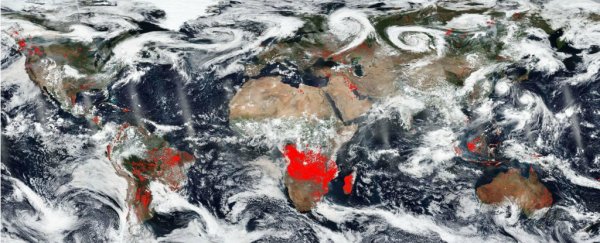NASA's Worldview program has some bad news. The Earth is on fire.
The red points in the picture above are areas around the world with fires actively burning, accurate as of Thursday. It doesn't look great.
The Worldview website lets you look at current events happening across the planet. One of those events is wildfires, detected through the use of thermal bands to mark any actively burning fires.
Now, as NASA notes in a statement, these aren't necessarily all wildfires - but it's still an impactful image.
We've all seen news about the fires in North America, but South America also has had a horrific number of fires this year.
And, as you can see on the map, Africa is actually the big one, with fires burning across large swaths of the southern parts of the continent.
"This could be due to the fact that these are most likely agricultural fires. The location, widespread nature, and number of fires suggest that these fires were deliberately set to manage land," a NASA spokesperson explains.
"Farmers often use fire to return nutrients to the soil and to clear the ground of unwanted plants. While fire helps enhance crops and grasses for pasture, the fires also produce smoke that degrades air quality."
Australia, and other areas in the Pacific are also suffering from wildfires and bushfires despite being in winter right now.
In fact, Australia is currently in the middle of an unusually severe drought through most of the country.
"Hotter, drier summers in Australia will mean longer fire seasons - and urban sprawl into bushland is putting more people at risk for when those fires break out," NASA explains.
"For large areas in the north and west, bushfire season has been brought forward a whole two months to August - well into winter, which officially began 1 June. According to the Australian Bureau of Meteorology, the January to July period 2018 was the warmest in NSW since 1910."
And there lies the kicker – this is not some freak event. As Cassandra Mosely explains at The Conversation, there are a number of reasons why wildfires are getting worse, including climate change.
The reasons "include climate change, past forest and fire management practices, housing development, increased focus on community protection and the professionalization of wildfire management," she writes.
"Fire seasons are growing longer in the United States and worldwide. According to the Forest Service, climate change has expanded the wildfire season by an average of 78 days per year since 1970."
Let's just hope we can get back some control over our world's climate, and make this map a little less red.
